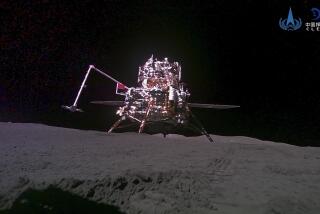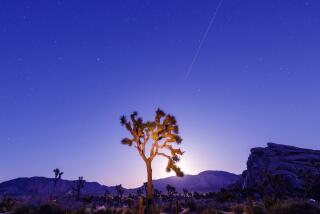Curiosity’s camera spies first asteroids seen from Martian surface
Gazing up at the Red Planet’s pair of moons, NASA’s Mars rover Curiosity has caught two famous asteroids zipping across the night sky – marking the first time such space rocks have ever been caught on camera from the Martian surface.
The rover’s Mast Camera snapped several images on April 20 of the moons Phobos and Deimos – but they specifically chose a time when Deimos would be near two notable asteroids, Ceres and Vesta. In the unannotated version of one image, Deimos looks like a bright disk in the lower right-hand corner, and scientists used 12-second exposures to capture Vesta and Ceres near the top left and right corners of the frame, respectively. The two asteroids appear as streaks because of the long exposure time. (Deimos, the moon, isn’t actually that big – it’s just so bright that it looks far larger than it actually is.)
Ceres and Vesta can both be seen with the naked eye from the Martian surface because they’re relatively close to the Red Planet. They inhabit the asteroid belt, a ring of rocky debris that stretches between the orbits of Mars and Jupiter. The pair reign supreme among the denizens of this planet-less zone: Ceres, which stretches about 590 miles across, is the largest asteroid and qualifies as a dwarf planet. Vesta is the second most massive but third-largest asteroid in the system, with a mean diameter of about 326 miles. (The asteroid Pallas is a little larger than Vesta but far less massive.)
NASA’s Dawn spacecraft first visited Vesta in 2011 and is set to rendezvous with Ceres next year, on a mission to study these two very different “protoplanets” – unused building blocks left over from the formation of the solar system.
Vesta and Ceres are much bigger than the Martian moons – the mean diameter of Phobos is about 14 miles, and the mean diameter of Deimos is less than 8 miles. In fact, Deimos might actually have been a free-floating asteroid earlier in its history, before being captured by Mars’ gravitational field.
Scientists had been using the rover, operated from Jet Propulsion Laboratory in La Cañada Flintridge, to stare at the night sky in order to test the air. Checking the clarity of the image could help them look for atmospheric interference from hazes and water-ice clouds, according to Mark Lemmon, a member of the Mastcam team based at Texas A&M University.
ALSO:
Hemihelix: Scientists use rubber to make shape rarely seen in nature
If it quacks like a bio-duck, it’s a minke whale
‘Wonder material’: Scientists produce graphene in kitchen blender
Meet Kepler-186f, the most ‘Earth-like’ planet ever found
Fruit flies make blazing fast turns like fighter jets







